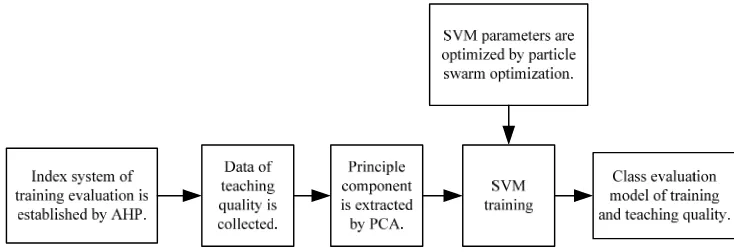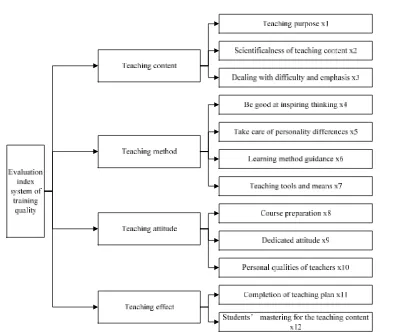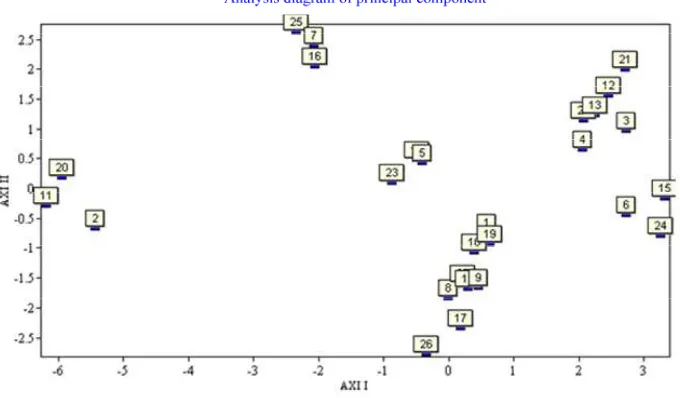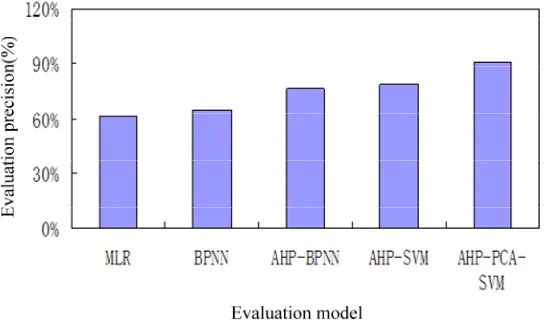DOI: 10.12928/TELKOMNIKA.v14i2A.4357 388
Education Training and Assessment for Medical Staff in
Network Information Sharing Model
Xiong Wei*, Guo Min, Tao Ye, Wang Hui
The Affiliated Hospital of Jilin Medical University, Jilin, 132013, China *Corresponding author, e-mail: xw016538@163.com
Abstract
In order to improve the evaluation precision of education and training quality, a kind of quality evaluation model of combined medical education and training course (AHPPCASV) is put forward, which is a combination of analytic hierarchy process, principal component analysis and support vector machine. Firstly, AHP is used to construct the evaluation index body, and then the principal component is used to select evaluation index; at last, input SVM to study the establishment of the quality evaluation model of medical education and training course. The simulation results show that AHPPCASVM has improved the evaluation precision of teaching quality and the evaluation efficiency.
Keywords: Analytic hierarchy process; Principal component analysis; Medical training; Teaching quality; Support vector machine
Copyright © 2016 Universitas Ahmad Dahlan. All rights reserved.
1. Introduction
With the scales amplification of medical institutions in our country, the service quality evaluation and monitoring of health service practitioners is the key link of teaching management and center of training and teaching management for medical practitioners. Training for medical practitioners as a public course is particularly important. Scientific evaluation of training quality of medical practitioners is conducive to improving teaching quality and finding problems in the teaching process. Thus, it is an important research course [1] in current educational reform of colleges and universities to establish training evaluation model which is the most suitable for medical practitioner.
The training teaching quality of traditional medical practitioners is evaluated by experts and the evaluation results are not scientific, but subjective and empirical, which can not accurately reflect the true level [2] of teachers. With the development of computer and intelligent theory, some qualitative and quantitative evaluation models of training and teaching quality of medical practitioners [3, 4] have appeared, of which, neural network has good ability of non-linear mapping and learning and is widely applied in the evaluation fields of teaching quality. However, neural network is a machine learning method based on empirical risk minimization principle, which requires a large amount of samples. If the sample size is limited, the reliability of evaluation result is relatively poor and incredible, so a large mount of teaching data will be required, which results in increasing [5] of evaluation cost. Support vector machine (SVM) is a new type of non-linear machine learning algorithm based on small samples, which preferably overcomes the defects requiring a large amount of samples of neural network and improves the evaluation precision of the teaching quality. However, in the evaluation process of teaching quality, there are two problems that need to be solved for SVM: one is the choice of evaluation index; the other is parameter optimization [6] of SVM.
ISSN: 1693-6930 389
2. Model Framework of Training Quality Evaluation of Medical Practitioner
The training process of medical practitioners is influenced by many factors, and influence of each factor is different for teaching effect, so it is difficult to establish accurate mathematical model [7-9]. The evaluation index of training quality of medical practitioner is set as {x1, x2, …, xm}, so mathematical expression of its teaching quality evaluation is
1,
2,
,
m
y
f x x
x
(1)In the expression,
f
()
refers to evaluation function.The establishment of evaluation model of training quality of medical practitioner is only to select important index from evaluation index system. Then find out the function f () that can reflect the relationship between them according to the result of index and teaching quality. First, AHP is used to establish evaluation index body of teaching quality in AHPPCASVM, and then PCA is used to select the principle component; at last, input the principle component into SVM to be trained and SVM parameters are optimized by chaos particle swarm optimization algorithm. In this way, the evaluation model of training quality which is the most suitable for medical practitioner is established. The framework of training quality of medical practitioner of AHPPCASVM is shown in Figure 1.
Figure 1. Model framework of training quality evaluation of medical practitioner
3. Evaluation Model of Teaching Quality of AHPPCASVM 3.1. Evaluation Index System Selected by AHP
Figure 2. Evaluation index system of training quality
3.2. Principle Component of Evaluation Index System Selected by PCA
The evaluation index system of training quality of medical practitioners has been established by AHP. However, multiple colinearities exist between these indexes and information redundancy is more serious. The method of principal component analysis (PCA) is a kind of data processing method that a small number of indexes are used to describe original index of teaching quality and to reduce the dimension of input vector. The steps of processing the evaluation index system of the training quality of PCA for medical practitioners are as follows:
(1) In order to eliminate the adverse effects of the data differences between the indexes for the learning course of SVM, normalization processing is complemented for them. Namely
ij j ij
j x x
y Y
s
(2)
In the formula, xj refers to index value, sj refers to Value J of Index i. (2) Covariance matrix of computing features S:
1
[ ) [ ]T
S Y Y l Y Y l
N
(3)
ISSN: 1693-6930 391
(4) Rank shall be performed according to characteristic value and accumulate the contribution rate of variance of principle component. When the accumulative contribution rate is over 85%, the number m of principle component can be gained at this time.
(5) These principle components can be input into SVM for study, which reduces the dimension of SVM input and improves the learning efficiency of SVM.
3.3. Classifier of Teaching Quality Evaluation
Support vector machine (SVM) is a statistical learning method based on the Structural Risk Minimization Principle. Its purpose is to find out an optimal hyperplane and guide this plane to meet the limiting condition of classification and can separate all points in Categorical Dataset. By means of nonlinear mapping function , the original data are mapped to high dimensional feature space to be classified for two types of evaluation problems of teaching quality. The optimal classification hyperplane is:
( ) ( ) 0
f x w x b (4)
Here,
w
refers to weight vector,b
refers to threshold value.Non-negative slack variable
i is imported to enhance generalization ability ofclassification of learning method. In this way, the classification is turned into:
1
In the formula, C is the penalty factor of error.
Above optimization problem is changed into antithesis form by importing Lagrange Multiplier Algorithm:
Here, the points corresponding to 0 are called support vector. By means of importing kernel function, Formula 5 is transformed into:
, 1 1
The optimal classification decision function of SVM is:
, 1
3.4. Working Steps of AHPPCASVM Model
(1) According to the actual requirements of the expert system, front-line teachers and teaching quality evaluation, analytic hierarchy process is used to establish the hierarchical index system structure of teaching quality evaluation.
(2) According to the evaluation index system selected by analytic hierarchy process (AHP), teaching quality data are collected.
(3) Use PCA to select evaluation index, and according to the evaluation index, the data of teaching quality is processed correspondently.
(4) Regard the evaluation index selected by PCA as input vector of SVM and the level of teaching quality as output of SVM to build the correspondent training set and test set.
(5) The teaching quality index is normalized to eliminate the negative effect of difference of index and dimension.
(6) Input the training set into SVM for study, use particle swarm optimization to find out optimal parameter C and σ of SVM to establish evaluation model of teaching quality.
(7) Use the evaluation model established to test the test set. If the precision is determined to the expected requirements, the optimal evaluation model of teaching quality is obtained.
(8) Use the optimal evaluation model of teaching quality to evaluate the teaching levels of teachers and output the correspondent evaluation levels.
4. Results and Analysis 4.1. Data Sources
In order to verify the performance of evaluation model of teaching quality of AHPPCASVM, the data of training quality of medical practitioners in Xichang College is used to for simulating it on the tool cabinet platform of Matlab 2009. 1000 data in total are collected. Each data includes 12 evaluation indexes and the level is divided into excellent ("1" as the representative), good ("2" as the representative), pass ("3", representative) and fail ("4", representative). Data of teaching quality is shown in Table 1.
Table1. Evaluation data of training quality of medical practitioners
No. x1 x2 x3 x4 … x12 y
4.2. Processing Data of PCA
ISSN: 1693-6930 393
Figure 3. Analysis results of indexes of PCA
Table 2. Results of indexes selected by PCA
No. Characteristic value Percentage % Accumulative percentage % 1 6.7772 56.4770 56.4770 2 2.0933 17.4438 73.9209 3 1.6305 13.5873 87.5082 4 0.5105 4.2538 91.7620 5 0.3326 2.7718 94.5338 6 0.2117 1.7642 96.2980 7 0.1682 1.4014 97.6994 8 0.1214 1.0116 98.7110 9 0.0628 0.5237 99.2347 10 0.0435 0.3627 99.5974 11 0.0289 0.2412 99.8386 12 0.0194 0.1614 100.0000
800 data are selected at random as training set of SVM; the other 200 data are regarded as test set. Then the training set is input into SVM for study and particle swarm optimization is used to optimize the parameters of SVM to establish corresponding optimal evaluation model with high teaching quality and test the test set. The precision of evaluation result of teaching quality is 90.84% and is over 85% with the general requirements. This indicates that it is suitable to use AHPPCASVM for evaluation of training quality of medical practitioners and the results obtained are reliable.
4.3. Compared with Performances of Other Models
Figure 4. Comparisons of evaluation precision of teaching quality of each model
The simulation result in Figure 4 is analyzed to obtain the following conclusions:
(1) Evaluation precision of composite model of AHP-BPNN, AHP-SVM and AHPPCASVM is higher than that of sole model MLR and BPNN, which indicates that composite model can realize the complementary advantages between models and overcome respective defects to improve the evaluation precision.
(2) Evaluation results of SVM and AHPPCASVM are superior to that of AHP-BPNN and AHP-BPNN, which mainly results from that although neural network has good nonlinear learning capacity, but its network structure is complex and its parameters are difficult to be confirmed, while the generalization ability of SVM is better. This indicates that it is right to select SVM in this paper to establish evaluation model of teaching quality.
(3) AHPPCASVM is better than other comparison models, which mainly results from that this model is integrated with the advantages of AHP、PCA and SVM. Evaluation indexes of teaching quality are confirmed scientifically by AHP and then PCA is used to process the evaluation indexes to remove redundant information between the indexes. At last, SVM with good nonlinear learning ability is used to establish the evaluation model of teaching quality, which can describe characteristic of teaching quality from many perspectives so as to obtain more scientific and credible evaluation results of teaching quality.
5. Conclusions
The training quality evaluation of medical practitioners is a complex and multi-factor non-linear classification problem. For this reason, a kind of evaluation model of teaching quality of AHPPCASVM is put forward. The simulation result indicates that the training speed of evaluation model is accelerated and the evaluation result can be used to actual teaching management.
Acknowledgements
The Education Department of Jilin Province, "12th Five-Year plan" science and technology research project (NO. 2014372) and The health department of Jilin province soft science research project (project number: 2013R012).
References
[1] Lin Y, Yang J, Lv Z. A Self-Assessment Stereo Capture Model Applicable to the Internet of Things.
Sensors. 2015; 15(8): 20925-20944.
ISSN: 1693-6930 395
[3] Joseph J. An Evaluation to Assess the Knowledge regarding Palliative Care in Neonatal Nursing among Staff Nurses Working in Selected Hospitals at Bangalore. International Journal of Public
Health Science (IJPHS). 2013; 2(2): 67-74.
[4] Lv Z, Halawani A, Feng S. Multimodal hand and foot gesture interaction for handheld devices. ACM
Transactions on Multimedia Computing, Communications, and Applications (TOMM). 2014; 11(1s):
10.
[5] Guanxiong Liu, Yishuang Geng, Kaveh Pahlavan. Effects of calibration RFID tags on performance of inertial navigation in indoor environment. Networking and Communications. 2015.
[6] T Sutikno, D Stiawan, IMI Subroto. Fortifying Big Data infrastructures to Face Security and Privacy Issues. TELKOMNIKA (Telecommunication Computing Electronics and Control). 2014; 12(4): 751-752.
[7] Milovic B. Prediction and decision making in Health Care using Data Mining. International Journal of
Public Health Science (IJPHS). 2012; 1(2): 69-78.
[8] Singh S, Chana I. Cloud based development issues: a methodical analysis.International Journal of
Cloud Computing and Services Science. 2013; 2(1): 73.



